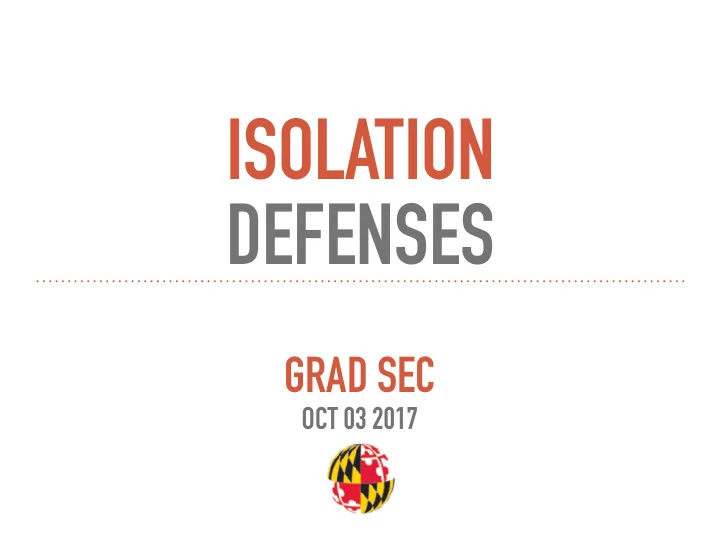

ISOLATION DEFENSES GRAD SEC OCT 03 2017
ISOLATION Running untrusted code in a trusted environment Possibly with multiple tenants Setting OS: users / processes Browser: webpages / browser extensions Cloud: virtual machines (VMs) Threat model Execution begins in the trusted environment Attacker can provide arbitrary code and data Attacker’s goal is to run arbitrary code or exfiltrate data Security goal Restrict the set of actions that an attacker can make
TODAY’S PAPERS
What have I done ISOLATION to deserve this?
SANDBOXES Execution environment that restricts what an application running in it can do Takes arbitrary x86, runs it in a sandbox in a browser NaCl’s restrictions Restrict applications to using a narrow API Data integrity: No reads/writes outside of sandbox No unsafe instructions CFI Chromium’s Runs each webpage’s rendering engine in a sandbox restrictions Restrict rendering engines to a narrow “kernel” API Data integrity: No reads/writes outside of sandbox (incl. the desktop and clipboard)
NACL CONSTRAINTS Applied to all untrusted binaries
NACL CONSTRAINTS What if we didn’t Attacker could overwrite the binary with code have this? (e.g., as a result of a wget) NaCl would have to statically analyze that new code Load binary with invalid instructions What if we only had this? ROP to make the binary writable
NACL CONSTRAINTS What if we didn’t Would render C5, C6, C7 useless have this? ⟹ Could not determine control transfer targets Alone, it is not checking for or preventing anything What if we only had this?
NACL CONSTRAINTS nacljmp (SFI) jmp %eax First byte is 64K (C2) and %eax, 0xffffffe0 jmp (%eax) What if we didn’t Attacker could potentially jump anywhere have this? ROP , code injection C1 necessary; C2 ensures these are instructions What if we only had this? C7 ensures that what it’s jumping to is valid
NACL CONSTRAINTS What if we didn’t Execution would continue beyond the executable itself have this? Could start to run data Provides no guarantees about what’s in the code itself What if we only had this?
NACL CONSTRAINTS What if we didn’t Would render nacljmp useless have this? ⟹ Wouldn’t know what exactly we’re jumping to Provides no guarantees about what we are jumping to What if we only had this?
NACL CONSTRAINTS What if we didn’t Could not perform disassembly have this? ⟹ Could not infer what instructions are called C1 still breaks it What if we only had this? Doesn’t say you can’t also hit invalid instructions
NACL CONSTRAINTS What if we didn’t Invalid instructions! have this? ⟹ Arbitrary syscalls, interrupts, loads, returns, … C1 still breaks it; C4: could execute beyond the binary What if we only had this? C2, C3, C5, C6 are needed to get to C7
NACL VALIDATOR C2: Known entry point C7: No invalid instructions C5: No invalid alignments C3: Only use nacljmp Common disassembly techniques
DISASSEMBLY Linear disassembly Start at instruction i i += inst_len(i) Leaves gaps if there are variable-length inst’s, data, bad alignment… Recursive disassembly Set of entry points E Start at entry point i if i is a jmp: add its target to E i += inst_len(i) Goal: CFI without access to code: How do you infer the control flow graph?
NACL VALIDATOR C2: Known entry point C7: No invalid instructions C5: No invalid alignments C3: Only use nacljmp Theorem : StartAddr contains all addresses that can be reached from an instruction with address in StartAddr.
NACL VALIDATOR: PROOF Theorem : StartAddr contains all addresses that can be reached from an instruction with address in StartAddr.
ACTUALLY DOING THINGS WITH NACL First 4KB: Unreadable, unwritable (detect NULL pointers) Remaining 60KB: trusted trampoline code (untrusted to trusted) & springboard return (trusted to untrusted) Ensures we have a Trusted Compute Base (TCB) in the malicious binary Allowed to contain instructions that are forbidden elsewhere Especially far call to enable control transfers between untrusted user code and trusted service runtime Separation is handled by setting / restoring segment registers, which locate the code/text segments
NACL’S SANDBOXES Inner sandbox Swap between untrusted & trusted Untrusted within a process via segment registers 3rd-party Untrusted code 3rd-party Trampoline data Trusted Trusted code data Springboard Outer sandbox System calls Mediates system calls at the process boundary
SECURITY DESIGN PRINCIPLES Defense in depth
SECCOMP-BPF • Linux system call enabled since 2.6.12 (2005) Affected process can subsequently only perform read, • write, exit, and sigreturn system calls No support for open call: Can only use already-open file descriptors - Isolates a process by limiting possible interactions • • Follow-on work produced seccomp-bpf Limit process to policy-specific set of system calls , • subject to a policy handled by the kernel Policy akin to Berkeley Packet Filters (BPF) - Used by Chrome , OpenSSH , vsftpd , and others •
TODAY’S PAPERS
CHROMIUM ARCHITECTURE Rendering Engine: Interprets and executes web content Outputs rendered bitmaps The website is the “untrusted code” Goal: Enforce a narrow interface between the two Browser Kernel: Stores data (cookies, history, clipboard) Performs all network operations
CHROMIUM’S SANDBOX Makes extensive use of the underlying OS’s primitives 1. Restricted security token The OS then provides complete mediation on access to “securable objects” (Security token set s.t. it fails almost always) 2. Separate desktop Avoid Windows API’s lax security checks 3. Windows Job Object Can’t fork processes; can’t access clipboard
CHROMIUM’S BROWSER KERNEL INTERFACE Goal: Do not leak the ability to read or write the user’s file system 1. Restrict rendering Rendering engine doesn’t get a window handle Instead, draws to an off-screen bitmap Browser kernel copies this bitmap to the screen 2. Network & I/O Rendering engine requests uploads, downloads, and file access thru BKI 3. Restrict user input Rendering engine doesn’t get user input directly Instead, browser kernel delivers it via BKI
Recommend
More recommend